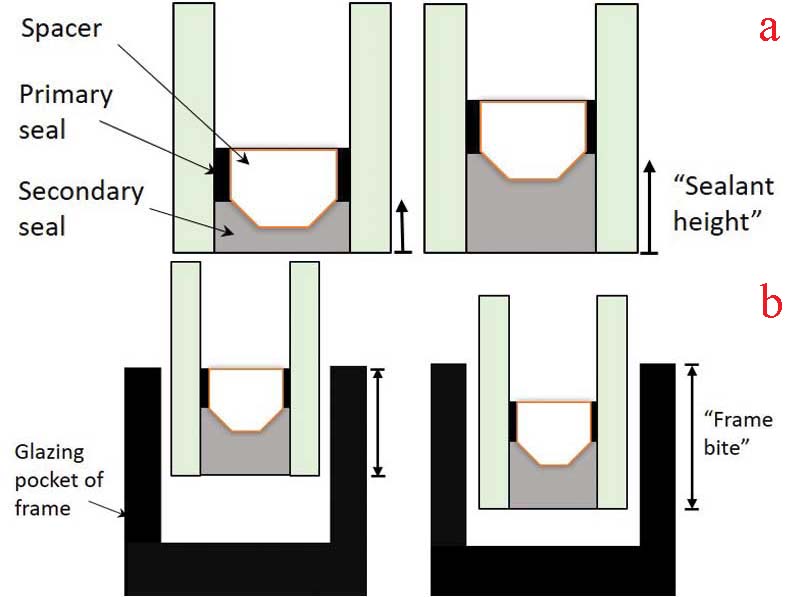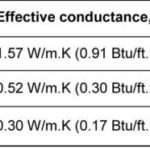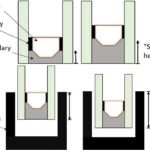The edge of glass
EOG comprises the spacer separating the panes of glass to create the IG cavity, and the attendant sealant materials. The linear conductance across these components (i.e. effective conductivity or Keff) determines the EOG thermal performance.
The EOG linear conductance is not the conductivity of the material from which the spacer is made. This point is illustrated by Figure 10, which compares the effective conductivity of different box spacers (i.e. aluminum, stainless steel, and plastic-hybrid stainless steel) with the bulk material conductivity. The spacer’s profile shape and wall thickness have significant impacts on the effective thermal conductance.
In addition to the conductance of the spacer, edge thermal performance significantly depends on the amount of secondary sealant used (Figure 11a) and on the coverage of the EOG by the frame (i.e. bite), as shown in Figure 11b. Increasing the sealant height from 2 to 5 mm (0.08 to 0.2 in.) can raise the edge’s linear thermal transmittance by more than 30 percent.
For this reason, it is extremely important to ensure any U-factor calculations include the correct sealant height for the project and comparisons between spacers and/or different edge-seal designs are made with the equivalent sealant heights. In commercial IGUs, a standard sealant height is typically about 6 mm (0.25 in.) to provide appropriate durability and structural performance. (It is often higher for large, structurally glazed units needing to withstand higher wind loads.)
The window’s U-factor can also be reduced somewhat by burying the edge seal deeper into the frame—the greater the edge bite, the better the overall performance. This can be a strategy when small improvements in performance are needed.
Spacer options and impact on whole-window performance
Spacers must perform many diverse functions in an IGU to effectively support the system’s longevity and thermal performance. One of these involves carrying desiccant, which absorbs moisture vapor as it enters the cavity through the edge seal.
The seals of an IGU are not hermetic since there is a finite water vapor transmission rate through them. Desiccant is used in the spacer to capture this moisture vapor and keep the cavity dry over its lifetime. An IGU fails when the desiccant capacity is fully used and additional moisture vapor can no longer be absorbed. This additional vapor then appears as condensation inside the cavity and/or corrodes the low-e coatings (if present). The goal of IGU design and fabrication is to minimize moisture vapor transmission rate.
Other functions an IGU must perform include:
- offering a gas barrier to minimize loss of argon
(or other inert gas) from the cavity; - accommodating stresses induced by thermal expansion and pressure changes in the sealed cavity;
- creating an insulating barrier that reduces the conduction of heat, lowering the unit’s U-factor
and reducing condensation at the edge; and - meeting structural and rigidity requirements
(e.g. installation into a pressure-plate curtain wall or a structural glazing application).
When specifying a spacer, it is important to keep in mind aspects related to durability and suitability for the glazing application, as well as thermal performance.
Rigid box spacers are the most common kind of spacer used in commercial glazing in the United States. As the name suggests, they are shaped like a box (see the spacer depicted in the edge seal in Figure 11) and their hollow interiors are used to carry desiccant. In the box spacer category, different material types—aluminum, stainless steel, and plastic-hybrid stainless steel—have a long track record of durability performance in insulating glass. This is in large part due to their rigidity, desiccant-holding capacity, water and gas barrier properties, and excellent sealant adhesion to metal surfaces.
Foam spacers, which contain an integrated desiccant matrix, are now also being promoted as an option for warm-edge in commercial glazing, as are 100 percent plastic box spacers. The backs of these spacers are wrapped with a thin, metalized plastic foil to act as a gas and moisture barrier.









